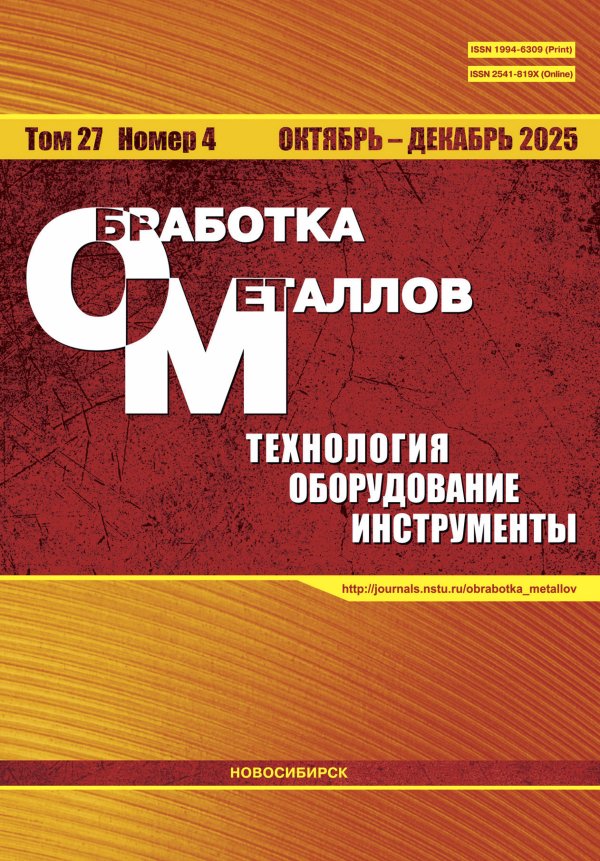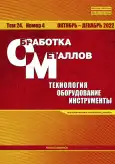Исследование взаимосвязи силы резания и шероховатости обработанной поверхности с подачей на зуб при фрезеровании материала EuTroLoy 16604, полученного DMD-методом
- Авторы: Дюрягин А.А.1, Ардашев Д.В.1
-
Учреждения:
- Выпуск: Том 24, № 4 (2022)
- Страницы: 6-17
- Раздел: ТЕХНОЛОГИЯ
- URL: https://bakhtiniada.ru/1994-6309/article/view/301869
- DOI: https://doi.org/10.17212/1994-6309-2022-24.4-6-17
- ID: 301869
Цитировать
Аннотация
Ключевые слова
Об авторах
А. А. Дюрягин
Email: s.dyuryagin@mail.ru
аспирант, Южно-Уральский государственный университет, пр. Ленина, 76, г. Челябинск, 454080, Россия, s.dyuryagin@mail.ru
Д. В. Ардашев
Email: ardashevdv@susu.ru
доктор техн. наук, доцент, Южно-Уральский государственный университет, пр. Ленина, 76, г. Челябинск, 454080, Россия, ardashevdv@susu.ru
Список литературы
- Шатульский А.А., Шаповалова М.А. Применение методов прототипирования для изготовления изделий машиностроения // Наукоемкие технологии в машиностроении. – 2011. – № 1. – С. 24–29.
- Zekovic S., Kovacevic R. Modeling of laser-based direct metal deposition // Tribology in Industry. – 2006. – Vol. 28. – P. 9–14.
- Imran M.K., Masood S.H., Brandt M. Direct metal deposition of H13 tool steel on copper alloy substrate: parametric investigation // Lasers in Manufacturing and Materials Processing. – 2015. – Vol. 2, iss. 4. – P. 242–260. – doi: 10.1007/s40516-015-0018-z.
- Wang X., Jiang J., Tian Y. A review on macroscopic and microstructural features of metallic coating created by pulsed laser material deposition // Micromachines. – 2022. – Vol. 13, iss. 5. – doi: 10.3390/mi13050659.
- Долговечный А.В., Демидова Л.А., Ханов А.М. Процесс структурообразования в покрытиях при лазернои? наплавке // Известия вузов. Порошковая металлургия и функциональные покрытия. – 2014. – № 1. – С. 49–55. – doi: 10.17073/1997-308X-2014-1-49-55.
- Еремина М.А., Ломаева С.Ф., Харанжевский Е.В. Структура и износостойкость покрытий, полученных высокоскоростной лазерной наплавкой механокомпозитов на основе карбогидрида титана // Известия вузов. Порошковая металлургия и функциональные покрытия. – 2021. – № 4. – С. 46–56. – doi: 10.17073/1997-308X-2021-4-46-56.
- Micro-milling machinability of DED additive titanium Ti-6Al-4V / G. Bonaiti, P. Parenti, M. Annoni, S. Kapoor // Procedia Manufacturing. – 2017. – Vol. 10. – P. 497–509. – doi: 10.1016/j.promfg.2017.07.104.
- Hybrid manufacturing: influence of material properties during micro milling of different additively manufactured AISI 316L / S. Greco, M. Schmidt, K. Klauer, B. Kirsch, J.C. Aurich // Production Engineering. – 2022. – doi: 10.1007/s11740-022-01139-6.
- Dilberoglu U.M., Gharehpapagh B., Yaman U. Current trends and research opportunities in hybrid additive manufacturing // The International Journal of Advanced Manufacturing Technology. – 2021. – Vol. 113. – P. 623–648. – doi: 10.1007/s00170-021-06688-1.
- Kim E.J., Lee C.M., Kim D.H. The effect of post-processing operations on mechanical characteristics of 304L stainless steel fabricated using laser additive manufacturing // Journal of Materials Research and Technology. – 2021. – Vol. 15. – P. 1370–1381. – doi: 10.1016/j.jmrt.2021.08.142.
- Szykiedans K., Credo W. Mechanical properties of FDM and SLA low-cost 3-D prints // Procedia Engineering. – 2016. – Vol. 136. – P. 257–262. – doi: 10.1016/j.proeng.2016.01.207.
- Cutting force and surface finish analysis of machining additive manufactured titanium alloy Ti-6Al-4V / A. Polishetty, M. Shunmugavel, M. Goldberg, G. Littlefair, R.K. Singh // Procedia Manufacturing. – 2017. – Vol. 7. – P. 284–289. – doi: 10.1016/j.promfg.2016.12.071.
- Machining of additively manufactured parts: implications for surface integrity / O. Oyelola, P. Crawforth, R. M’;Saoubi, A.T. Clare // Procedia CIRP. – 2016. – Vol. 45. – P. 119–122. – doi: 10.1016/j.procir.2016.02.066.
- Manna A., Bhattacharayya B. A study on machinability of Al/SiC-MMC // Journal of Materials Processing Technology. – 2003. – Vol. 140. – P. 711–716. – doi: 10.1016/S0924-0136(03)00905-1.
- Influence of cutting conditions on the surface roughness of titanium-alloy parts produced by additive and traditional methods / K.R. Muratov, E.A. Gashev, T.R. Ablyaz, A.A. Panteleev // Russian Engineering Research. – 2021. – Vol. 41, iss. 5. – P. 434–436. – doi: 10.3103/S1068798X21050129.
- A comparative study of dry and cryogenic milling for Directed Energy Deposited IN718 components: effect on process and part quality / T. Souflas, H. Bikas, M. Ghassempouri, A. Salmi, E. Atzeni, A. Saboori, I. Brugnetti, A. Valente, F. Mazzucato, P. Stavropoulos // The International Journal of Advanced Manufacturing Technology. – 2022. – Vol. 119. – P. 745–758. – doi: 10.1007/s00170-021-08313-7.
- An experimental investigations on effects of cooling/lubrication conditions in micro milling of additively manufactured Inconel 718 / M. Danish, K. Aslantas, A. Hascelik, S. Rubaiee, M.K. Gupta, M.B. Yildirim, A. Ahmed, A. Mahfous // Tribology International. – 2022. – Vol. 173. – P. 1–13. – doi: 10.1016/j.triboint.2022.107620.
- Experimental studies on fabricating functionally gradient material of stainless steel 316L-Inconel 718 through hybrid manufacturing: directed energy deposition and machining / R. Zhang, K.M. Nagaraja, N. Bian, E. Fisher, S. Ahmadyar, K. Bayazitoglu, H. Lu, W. Li // The International Journal of Advanced Manufacturing Technology. – 2022. – Vol. 120. – P. 7815–7826. – doi: 10.1007/s00170-022-09304-y.
- Study of the structural characteristics of titanium alloy products manufactured using additive technologies by combining the selective laser melting and direct metal deposition methods / M. Samodurova, I. Logachev, N. Shaburova, O. Samoilova, L. Radionova, R. Zakirov, K. Pashkeev, V. Myasoedov, E. Trofimov // Materials. – 2019. – Vol. 12. – doi: 10.3390/ma12193269.
- Режимы резания металлов: cправочник / Ю.В. Барановский, Л.А. Брахман, А.И. Гдалевич и др. – 4-е изд., перераб. и доп. – М.: НИИТавтопром, 1995. – 456 с.
- Study on microstructure, mechanical properties and machinability of efficiently additive manufactured AISI 316L stainless steel by high-power direct laser deposition / P. Guo, B. Zou, C. Huang, H. Gao // Journal of Materials Processing Technology. – 2017. – Vol. 240. – P. 12–22. – doi: 10.1016/j.jmatprotec.2016.09.005.
Дополнительные файлы







